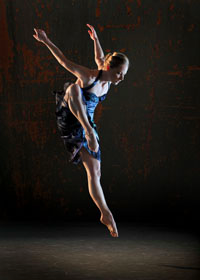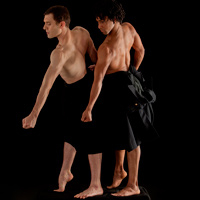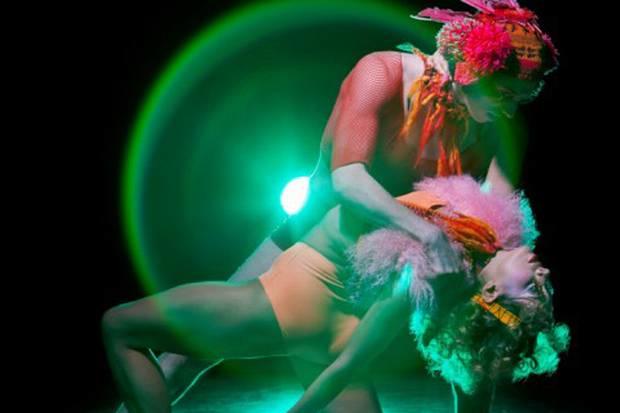The past is a hard card to play for a contemporary dance company, even harder than for a ballet company. A work that’s proved over time, whose quality emerges and re-emerges with revisiting, casts an imposing shadow over new works created in the ethos and fashions of the contemporary. Rambert’s director for the past decade, Mark Baldwin, has always turned with love to past works, and he must know that it’s Siobhan Davies’s 1995 The Art of Touch on this 10th anniversary programme that is by far its star, and shows just what richly refined and responsive individuals he now numbers in his elite band.
This is, simply, a masterpiece of musical choreography, both a dance-poem to courtly love in a long-past era, and yet astoundingly and vividly expressive of the essence of the harpsichord, the instrument whose plucked and buzzing strings define it. Set between shadowy, renaissance gold walls, the seven dancers in dark eveningwear might be the seven notes of the sol-fa scale, while the series of dances leap in and out of the textures of baroque Scarlatti sonatas and Matteo Fargion's taut modern variations on them.
 The sheer calligraphy is exultant, as hands snap and bare feet whiffle through the air like the action of quill upon string inside the harpsichord. But you also feel the tenderness of it, the man and woman who lovingly welcome the unborn child that links them, the flame-like Pieter Symonds as a lone woman relishing the speed of untrammelled life, and the suspenseful moments when the seven negotiate who’s joining the scale, who will help form the chords, and who is feeling a little flattened and melancholy.
The sheer calligraphy is exultant, as hands snap and bare feet whiffle through the air like the action of quill upon string inside the harpsichord. But you also feel the tenderness of it, the man and woman who lovingly welcome the unborn child that links them, the flame-like Pieter Symonds as a lone woman relishing the speed of untrammelled life, and the suspenseful moments when the seven negotiate who’s joining the scale, who will help form the chords, and who is feeling a little flattened and melancholy.
These little dramas are lightly fashioned, but with a sophisticated wit, and while there are a few choreographers who also can achieve such delicate human eloquence, there are none, I think, who shape movement phrases with such refined sense of destination. Wonderful Davies, wonderful dancing - Symonds, Jonathan Godard, Angela Towler, Gemma Nixon (pictured left by Hugo Glendinning), Robin Gladwin, Eryck Brahmania and Patricia Okenwa, and absorbing harpsichord playing too by Carole Cerasi.
Another blast from the even older past follows, the historic icon of Nijinsky’s L’après-midi d’un faune, which now makes, very unexpectedly, three outings for this hallowed ghost in London this spring (English National Ballet and Ivan Putrov’s band being the others). And this by far the best performed, its curious antique styling muted in the Rambert designs (as if Bakst’s cloth had been left out for decades in the rain), but a forceful sexuality and mythical remoteness in Dane Hurst’s exciting performance as the Faun.
The moves are famously hieratic. Compressed and two-dimensional, the Faun and the nymphs he barges in on can seem quaint and puppet-like if not believed in by the performers. But some scrupulous weighting, grading and sifting must have gone on in the rehearsing. Michael Jackson’s slippery moonwalk, they say, came from Cab Calloway in the Thirties - but if Hurst’s steps are right, that ole moonwalk came straight from the feet of Nijinsky as the Faun a century ago.
 Baldwin’s selection of new repertoire and his own choreography hasn’t been able consistently to match the appreciation he has for Rambert’s heritage, and Itzik Galili no more proves with his second work bought in by Rambert, Sub, that he offers anything better than primitivist carnival vigour to these superb dancers than he did with A Linha Curva.
Baldwin’s selection of new repertoire and his own choreography hasn’t been able consistently to match the appreciation he has for Rambert’s heritage, and Itzik Galili no more proves with his second work bought in by Rambert, Sub, that he offers anything better than primitivist carnival vigour to these superb dancers than he did with A Linha Curva.
Sub is far more earnest than the other, a hoe-down for seven men in ruched grey culottes and bare chests (pictured right), with some exacting lighting effects (including smoking footlights), and a hard-scrubbing taped score by Michael Gordon. The careful windmilling of arms and sweeping of legs retreads, without tension or surprises, same-old same-old heavy contemporary moves. I don’t see its purpose in Rambert’s repertoire, its representation of current choreography is dated, its momentum is underpowered, and far too much freight seems to have been given to its stage look and “feel”.
Baldwin has, to be frank, fallen into frantic feyness in his visual taste more than once before
Which again is a fault in Baldwin’s new work, What Wild Ecstasy. Baldwin has, to be frank, fallen into frantic feyness in his visual taste more than once before - how could we forget the toucan in Eternal Light, or the tinfoil humanoid in Comedy of Change? And it’s more and more irritating that he continues to summon the karaoke party costumes at the expense of the cool, balletically poised choreography that he’s writing.
There is said to be some connection between this new work and the Nijinsky - possibly the wild feather headdresses echo those in the original Firebird ballet a century ago, possibly the idea of recklessness in the woods. But the pink pants on hairy legs? The gigantic wasps hanging mid-air? The shower of tennis balls? Michael Howells is the guilty designer, an old hippy high as a kite on memories of bandana and dreadlocks days.
Somewhere in the midst of these woolly excrescences, there’s a dance going on that would look just fine in plain costumes in an empty space, so that one could sense whether the richness and great interest of Gavin Higgins’ new commission for the Rambert Orchestra really does find enough of a response in Baldwin’s genteel dance-writing. As it is, though, I think Baldwin’s making his dancers and his own dance look ridiculous.














Add comment